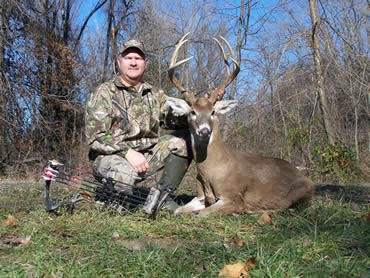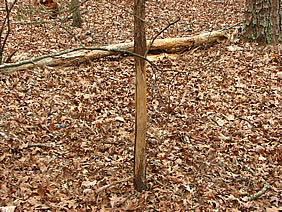Rubs have been shrugged off as scouting tools, but they can be an important part of the buck equation.
To many deer hunters, at least those who don’t play an instrument, buck rubs are like sheet music. They know what they’re looking at and that it contains a lot of information, but they’re not sure about the melody — or, in the case of the rubs, the message.
Like sheet music, rubs often look the same from a distance. For those who know what to look for, however, they can tell you a lot about the deer that made them.
Some biologists believe bucks prefer to rub trees with highly visible underbarks and strong aromas. Brad Harris, legendary hunter and co-owner of Southern Cross Ranches, says that’s not entirely true.
“It depends on the buck and the area,” he said. “Some bucks prefer softer trees like cedars, while others prefer extremely hard trees like Osage orange.”
A lot has been written, too, about the different types of rubs. Some claim there are only two main types, while others believe there are six or more. I’ve talked to a lot of rub experts, and for the purposes of hunting and to keep things simple, I separate rubs into three main types.
Throughout most of the whitetail’s range, a surge in testosterone in late September causes a buck’s antlers to harden and the velvet to fall off. The loss of velvet happens quickly, so the notion that bucks rub trees just to remove velvet has largely been dismissed. Even so, I like to call all the early season rubs velvet rubs.
Velvet rubs can give you an indication of the buck that made them, but little else. Rubs on large trees, particularly those with a lot of damage, could indicate they were made by a mature buck. But velvet rubs are made randomly, so they won’t tell you where the buck will be come hunting season.
Cluster rubs are found near sanctuaries, staging areas or other places where bucks hang out. Usually made later in the fall, cluster rubs can help you pinpoint a buck’s whereabouts, especially if they’re made over an extended period.
Cluster rubs old and new let you know a buck is spending a lot of time in an area. It’s a good idea to set a stand near, but not too close to, cluster rubs and hunt there before the rut kicks in. Don’t spend too much time setting stands or scouting near cluster rubs or you’ll risk running off the artist that made them.
 The most important rub from a hunting standpoint is the signpost rub.
The most important rub from a hunting standpoint is the signpost rub.
These rubs serve as boundary markers. They’re made by mature bucks to establish territory and send a message to other bucks to stay out.
“Signpost rubs are made year after year on the same trees,” said Brian Murphy, wildlife biologist and director of the Quality Deer Management Association. “They tend to be made where different area types come together.”
Bucks create and revisit signpost rubs surrounding the breeding season.
“Most signposts are made during the pre-rut and then again during the post-rut phase of the breeding cycle,” Murphy said.
Harris has used information gained from signpost rubs to harvest monster bucks.
“A few years ago, I was hunting in Iowa,” he said. “At daylight, my cameraman and I eased our way through some timber pockets. We found numerous fresh rubs in an area, and that indicated a buck had been spending a lot of time there. The wind was right, so we set up near the rubs. I killed a 150-inch 10-pointer 35 minutes before dark.”
Understanding rubs is an art and a science. My experience sometimes goes against what biologists write about rubs. Nowhere is this more evident than in the notion that only big bucks make big rubs.
“I do not find big rubs — those that are 20 inches or more in circumference — unless there are big bucks in the area,” observes wildlife biologist Dr. Grant Woods.
This is generally true, but certainly not always. A few years ago, a friend set up a trail camera near a fence post that had been mangled by rubbing bucks. He photographed six different bucks rubbing the fence post, but not one of them was what most hunters would consider a trophy.
While a large rub doesn’t always mean a large buck made it, rubs on trees that are 8 inches in diameter or more indicate a big buck is the maker.
“When you find rubs on trees as big around as your thigh, that indicates a mature buck with some heavy duty antlers,” Harris said.
The next thing to look at is how far from the ground the rub was made.
“Young bucks generally rub an area 14 to 30 inches up the tree, whereas rubs from older bucks are often 24 to 48 inches high,” noted Eberhart.
When examining a rub, look closely for gouge marks made by individual tines.
 “I look at the depth of the gouges and their diameter,” said Leading Ladies Outdoors hunter Tammy Koenig. “If a buck has substantial brow tines, you’ll see a lot of damage made by them in the middle of the tree.”
“I look at the depth of the gouges and their diameter,” said Leading Ladies Outdoors hunter Tammy Koenig. “If a buck has substantial brow tines, you’ll see a lot of damage made by them in the middle of the tree.”
Also take note of any gouges made by a buck’s antlers around the tree. They can tell you a lot about the size of a rack. Sometimes you’ll notice damage on finger-size branches near a rub. You can often picture how big a rack would have to be to catch and damage those satellite branches.
Also look for hoofprints. Large tracks with rounded toes often are the calling cards of a mature buck.
Next, determine if a rub is part of rub line. Kneel down next to the rub and look for similar rubs at the same height on other trees. Murphy says finding a fresh rub line on bigger-than-average trees indicates you’ve uncovered a big buck’s core area.
Remember that a rub on one side of the tree means the buck was traveling in the opposite direction. For instance, finding a rub on the north side of a tree means the buck was traveling south.
Finally, and perhaps most important, learn to estimate the age of each rub you find. Doing so will help you determine if it’s worth your time to hunt a particular spot or if the bucks might have transitioned out of the area.
Aging rubs can be a tricky business. Environmental factors such as heat, wind and rain affect how quickly rubs age. You also have to factor in tree species, amount of sunlight and the grade of the slope the tree is on. Still, there are some general characteristics that distinguish fresh rubs from those made months earlier.
Fresh rubs will be bright in color with a moist underbark, often with sap dripping from the wound. Look for fresh bark fragments around the base of the tree.
Rubs made just hours earlier often have a greenish tint. A rub that’s a week or two old will be drier and slightly faded. The edges of the rub will be dry, and it won’t be easy to see bark shavings on the ground.
Rubs that are months old look gray, and there won’t be any bark fragments around the tree. In the South, mold often grows on the wound because of high heat and humidity.
Rubs a year or more old will be healing. The edges around the wound often have bulbous ridges, and sometimes you’ll see vertical cracks where the bark has split from lack of moisture.
Don’t overlook the information you can gather from old rubs. If you find a rub in mid-November that was made some time in October, you might have found where a buck hangs out prior to the rut transition. It could be a great place to hang a stand next October.
Whitetails gravitate to different areas throughout the year, and they’ll move several times during the hunting season. If you know where to hang stands and hunt during those stages, you’ll dramatically increase your odds of success.
Deer use rubs to communicate with each other, and that means you can take advantage of fake rubs to send a message of your own.
“I once found this area with a couple of big rubs and a bunch of little saplings that had been ripped up and snapped off,” recounts Koenig. “I took a set of sheds and started ripping up small saplings in the same area he did. When I came back the next day, the buck had ripped and snapped off all the little trees around the ones I had damaged.
“I created more rubs with my sheds, and the buck responded again. Soon, there was an area about 20 feet in circumference that was completely cleared off. Two weeks later, my husband hunted that area and shot a record-book buck.”
No single type of deer sign is the magic bullet to indicate where to hang a stand, but rubs certainly tell you a buck was in the area. If you look a little closer, it will tell you when and sometimes why he’s using a particular trail or area.
Put together with other scouting information about food sources, funnels, bedding areas and travel corridors, rubs are an important piece of the puzzle to help you tag bucks consistently.
Read Recent Articles:
• Supersized! Put on your bibs, because here are a couple of ’Bama whitetails that’ll make you drool!
• Do Buck Limits Matter? If success rates are relatively low, why do we even have buck limits?
• Scoring From Ground Zero: You can’t always find a climbable tree in good whitetail habitat.
This article was published in the October 2010 edition of Buckmasters Whitetail Magazine. Subscribe today to have Buckmasters delivered to your home.